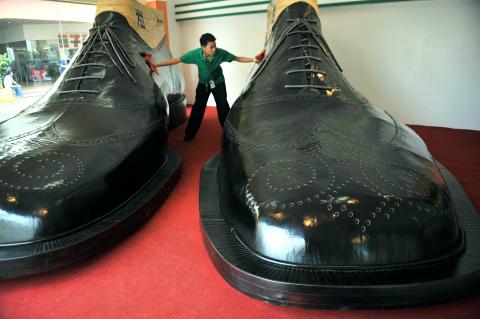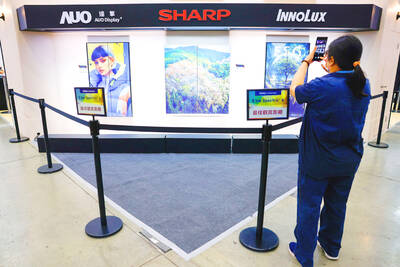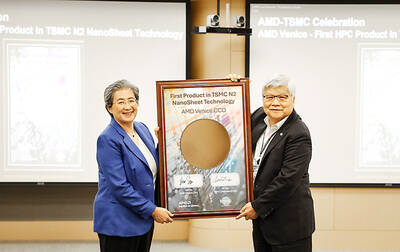A museum displaying the famed shoe collection of ex-first lady Imelda Marcos has reopened in the Philippines, heralding a fightback by its beleaguered shoe industry against a flood of cheap imports.
The museum is not just a showcase of the best of Marcos’ 3,000-pair collection, but also of the craftsmanship in shoe-making in the riverside eastern suburb of Marikina where the industry was born over a century ago.
Footwear consultant Tessie Endriga said that Marcos failed to provide the Marikina shoe industry with much-needed infrastructure or financing when her husband was in power. However, she did help in her own way.

Photo: AFP
“She did patronize local brands. If she liked a certain style, she would buy a dozen pairs,” said Endriga, who has worked with the government’s Bureau of Product Standards.
Marikina shoes were once famous, until low-priced footwear from countries like China and Vietnam flooded the industry over the years, local business leader Jose Tayawa said.
“You buy Marikina-made shoes and use them for five years. You buy Chinese shoes for one-fifth the price, but you can only use them for a few months,” said Tayawa, the head of the Marikina Chamber of Commerce and Industry.
Former shoe museum curator Dolly Borlongan conceded that most of Marcos’ shoes were imported, but added that there are many Marikina shoes among them, as well as displays on Marikina’s shoe-making history.
The museum was set up in 1998 as just one more way for Marikina to advertise its century-long history of making footwear, from humble slippers to rugged work boots to high-fashion custom shoes.
The town has also built the world’s largest shoes — a pair of leather men’s shoes, each as large as a van — which are still on display at a Marikina mall.
Generations of Filipinos grew up wearing the local products, and Marikina-made snake-skin shoes became the toast of Manhattan’s Fifth Avenue in the early-1980s, the city boasts on its Web site.
However, Marikina’s shoe--makers — and the shoe museum — have suffered setbacks in recent years. Massive flooding from Tropical Storm Ketsana last year damaged the museum, as well as many shoe-makers’ facilities and inventory.
The storm and the foreign competition took their toll. From the mid-1990s peak of 3,000, only about 200 Marikina shoemaking factories remain, said Roger Py, director-general of the Philippine Footwear Federation.
However, late last month, the museum reopened, just one of the moves that Marikina officials and businessmen hope will turn the footwear industry around, city administrator Victoriano Sabiniano said.
Tourists who visited the museum tended to look for a place to buy Marikina shoes, officials said, so the city is setting up a permanent shoe expo in a central area to sell its key product and spread the word about its quality.
“Step one is the local market. Once we fix that, we can go abroad,” Sabiniano said.
Quality was never the problem, Endriga said.
“We have come up with excellent shoes. The quality of craftsmanship in the Philippines can compete with Italy,” she said.
However, “I won’t say the shoe industry is dying, but it is missing out on a lot of opportunities,” she said.
Government figures show that Philippine footwear exports last year dropped 19.5 percent over the previous year to US$25.96 million.
Exports hit their peak at US$176.3 million in 1994, but have fallen sharply over the years.
Many visiting foreign buyers are still impressed by the quality of Philippine footwear, said Merlinda Diaz, an officer in the government’s Bureau of Export Trade Promotion.
“But then they ask for China-level prices and the deal falls through,” Diaz said.
The solution is not to compete with the high-volume production of these countries, he said.
“We avoid meeting the competition head-on in the cheap footwear sector. We go for the middle and the high-end,” said Py, who also heads Stefano Footwear, a major local manufacturer.
The local cobblers are now targeting smaller boutique stores in developed countries, where low prices are not the main attraction, he said.
The rising wages in China are also making Marikina shoes more competitive, Py added.

Taiwan will prioritize the development of silicon photonics by taking advantage of its strength in the semiconductor industry to build another shield to protect the local economy, National Development Council (NDC) Minister Paul Liu (劉鏡清) said yesterday. Speaking at a meeting of the legislature’s Economics Committee, Liu said Taiwan already has the artificial intelligence (AI) industry as a shield, after the semiconductor industry, to safeguard the country, and is looking at new unique fields to build more economic shields. While Taiwan will further strengthen its existing shields, over the longer term, the country is determined to focus on such potential segments as

UNCERTAINTY: Innolux activated a stringent supply chain management mechanism, as it did during the COVID-19 pandemic, to ensure optimal inventory levels for customers Flat-panel display makers AUO Corp (友達) and Innolux Corp (群創) yesterday said that about 12 to 20 percent of their display business is at risk of potential US tariffs and that they would relocate production or shipment destinations to mitigate the levies’ effects. US tariffs would have a direct impact of US$200 million on AUO’s revenue, company chairman Paul Peng (彭雙浪) told reporters on the sidelines of the Touch Taiwan trade show in Taipei yesterday. That would make up about 12 percent of the company’s overall revenue. To cope with the tariff uncertainty, AUO plans to allocate its production to manufacturing facilities in

COLLABORATION: Given Taiwan’s key position in global supply chains, the US firm is discussing strategies with local partners and clients to deal with global uncertainties Advanced Micro Devices Inc (AMD) yesterday said it is meeting with local ecosystem partners, including Taiwan Semiconductor Manufacturing Co (TSMC, 台積電), to discuss strategies, including long-term manufacturing, to navigate uncertainties such as US tariffs, as Taiwan occupies an important position in global supply chains. AMD chief executive officer Lisa Su (蘇姿丰) told reporters that Taiwan is an important part of the chip designer’s ecosystem and she is discussing with partners and customers in Taiwan to forge strong collaborations on different areas during this critical period. AMD has just become the first artificial-intelligence (AI) server chip customer of TSMC to utilize its advanced

Chizuko Kimura has become the first female sushi chef in the world to win a Michelin star, fulfilling a promise she made to her dying husband to continue his legacy. The 54-year-old Japanese chef regained the Michelin star her late husband, Shunei Kimura, won three years ago for their Sushi Shunei restaurant in Paris. For Shunei Kimura, the star was a dream come true. However, the joy was short-lived. He died from cancer just three months later in June 2022. He was 65. The following year, the restaurant in the heart of Montmartre lost its star rating. Chizuko Kimura insisted that the new star is still down